RENAULT KANGOO ZERO EMISSION 2012 X61 / 2.G Workshop Manual
Manufacturer: RENAULT, Model Year: 2012, Model line: KANGOO ZERO EMISSION, Model: RENAULT KANGOO ZERO EMISSION 2012 X61 / 2.GPages: 213, PDF Size: 6.08 MB
Page 51 of 213
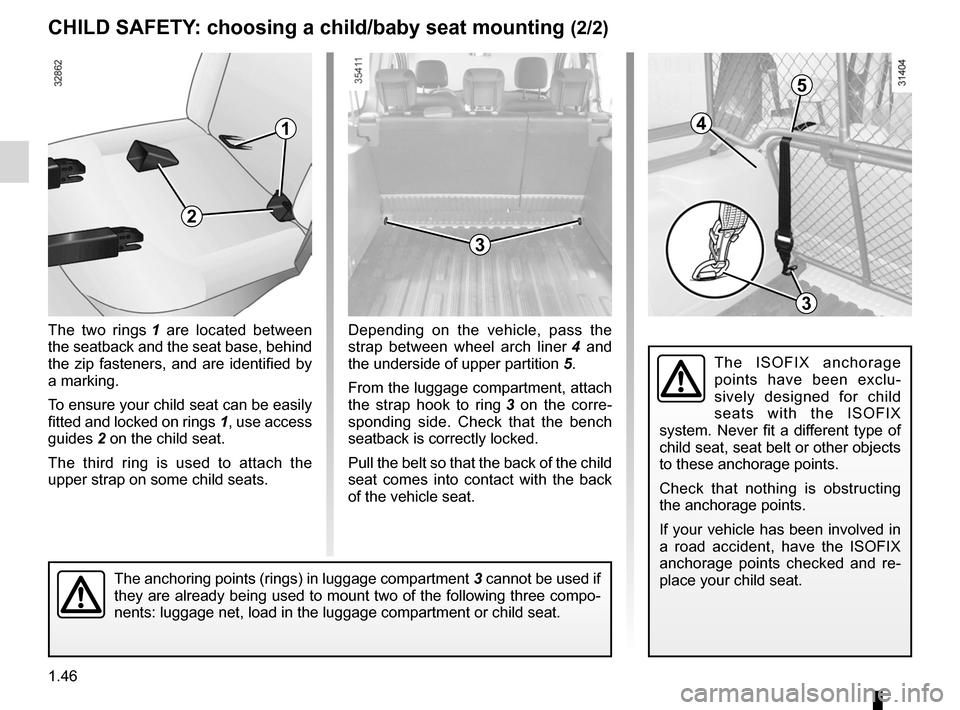
1.46
ENG_UD26785_4
Sécurité enfants : choix de la fixation siège enfant (X61 - F6\
1 - K61 - Renault)
ENG_NU_911-4_F61e_Renault_1
The two rings 1 are located between
the seatback and the seat base, behind
the zip fasteners, and are identified by
a marking.
To ensure your child seat can be easily
fitted and locked on rings 1, use access
guides 2 on the child seat.
The third ring is used to attach the
upper strap on some child seats.
3
chilD SAFetY : choosing a child/baby seat mounting (2/2)
Depending on the vehicle, pass the
strap between wheel arch liner 4 and
the underside of upper partition 5.
From the luggage compartment, attach
the strap hook to ring 3 on the corre -
sponding side. Check that the bench
seatback is correctly locked.
Pull the belt so that the back of the child
seat comes into contact with the back
of the vehicle seat.
The ISOFIX anchorage
points have been exclu -
sively designed for child
seats with the ISOFIX
system. Never fit a different type of
child seat, seat belt or other objects
to these anchorage points.
Check that nothing is obstructing
the anchorage points.
If your vehicle has been involved in
a road accident, have the ISOFIX
anchorage points checked and re -
place your child seat.
The anchoring points (rings) in luggage compartment 3 cannot be used if
they are already being used to mount two of the following three compo-
nents: luggage net, load in the luggage compartment or child seat.
4
5
3
1
2
Page 52 of 213
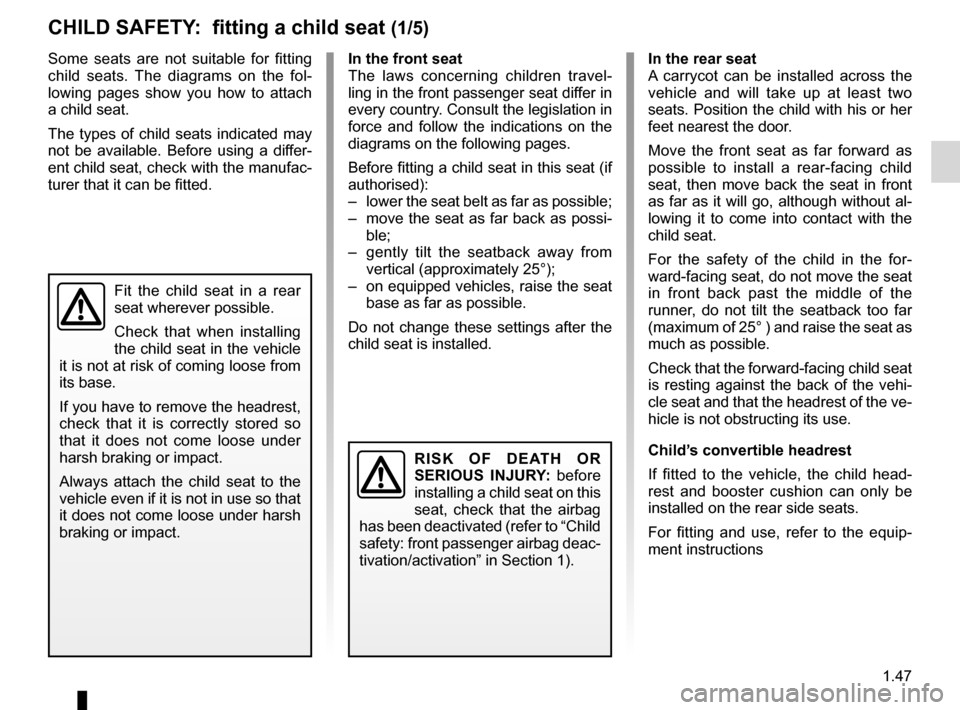
child seats............................................. (up to the end of the DU)
Isofix ..................................................... (up to the end of the DU)
child safety ............................................ (up to the end of the DU)
child restraint/seat ................................ (up to the end of the DU)
transporting children ............................. (up to the end of the DU)
child restraint/seat ................................ (up to the end of the DU)
1.47
ENG_UD26558_3
Sécurité enfants : installation du siège enfant (X61 - F61 - R\
enault)
ENG_NU_911-4_F61e_Renault_1
Fitting a child seat
Some seats are not suitable for fitting
child seats. The diagrams on the fol -
lowing pages show you how to attach
a child seat.
The types of child seats indicated may
not be available. Before using a differ-
ent child seat, check with the manufac-
turer that it can be fitted.
chilD SAFetY : fitting a child seat (1/5)
in the rear seat
A carrycot can be installed across the
vehicle and will take up at least two
seats. Position the child with his or her
feet nearest the door.
Move the front seat as far forward as
possible to install a rear-facing child
seat, then move back the seat in front
as far as it will go, although without al-
lowing it to come into contact with the
child seat.
For the safety of the child in the for -
ward-facing seat, do not move the seat
in front back past the middle of the
runner, do not tilt the seatback too far
(maximum of 25° ) and raise the seat as
much as possible.
Check that the forward-facing child seat
is resting against the back of the vehi-
cle seat and that the headrest of the ve-
hicle is not obstructing its use.
child’s convertible headrest
If fitted to the vehicle, the child head -
rest and booster cushion can only be
installed on the rear side seats.
For fitting and use, refer to the equip -
ment instructions
in the front seat
The laws concerning children travel
-
ling in the front passenger seat differ in
every country. Consult the legislation in
force and follow the indications on the
diagrams on the following pages.
Before fitting a child seat in this seat (if
authorised):
– lower the seat belt as far as possible;
– move the seat as far back as possi-
ble;
– gently tilt the seatback away from
vertical (approximately 25°);
– on equipped vehicles, raise the seat
base as far as possible.
Do not change these settings after the
child seat is installed.
r i S K O F D eAt h O r
S eri OUS iNJU rY: before
installing a child seat on this
seat, check that the airbag
has been deactivated (refer to “Child
safety: front passenger airbag deac-
tivation/activation” in Section 1).
Fit the child seat in a rear
seat wherever possible.
Check that when installing
the child seat in the vehicle
it is not at risk of coming loose from
its base.
If you have to remove the headrest,
check that it is correctly stored so
that it does not come loose under
harsh braking or impact.
Always attach the child seat to the
vehicle even if it is not in use so that
it does not come loose under harsh
braking or impact.
Page 53 of 213
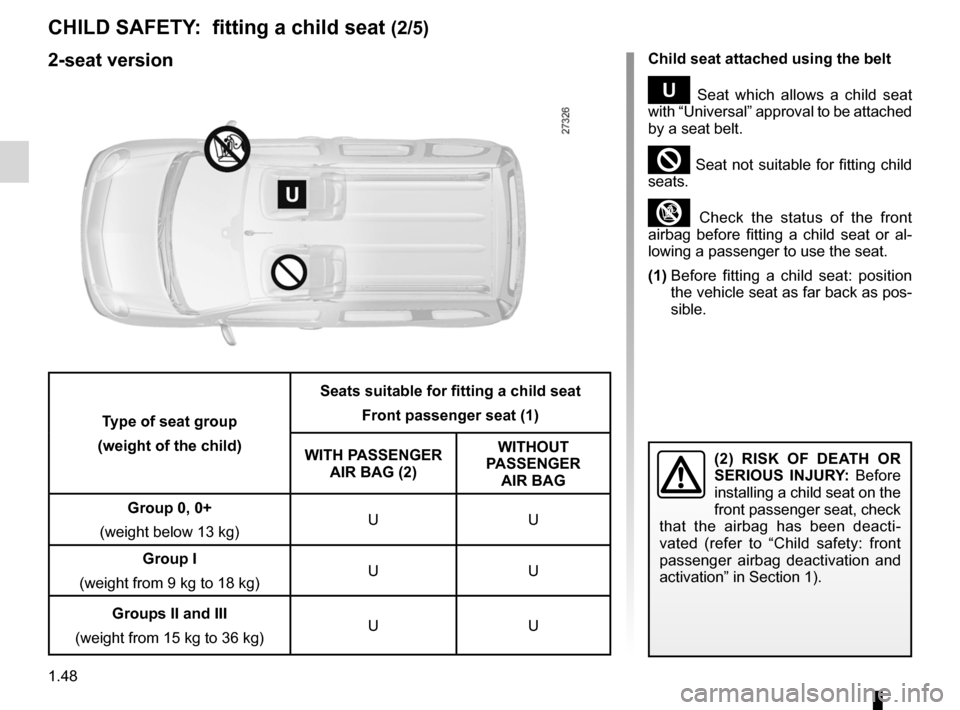
1.48
ENG_UD26558_3
Sécurité enfants : installation du siège enfant (X61 - F61 - R\
enault)
ENG_NU_911-4_F61e_Renault_1
Jaune NoirNoir texte
chilD SAFetY : fitting a child seat (2/5)
child seat attached using the belt
¬ Seat which allows a child seat
with “Universal” approval to be attached
by a seat belt.
² Seat not suitable for fitting child
seats.
³ Check the status of the front
airbag before fitting a child seat or al -
lowing a passenger to use the seat.
(1) Before fitting a child seat: position
the vehicle seat as far back as pos-
sible.
type of seat group
(weight of the child) Seats suitable for fitting a child seat
Front passenger seat (1)
With PASSeNger Air BAg (2) WithOUt
PASSeNger Air BAg
group 0, 0+
(weight below 13 kg) U
U
group i
(weight from 9 kg to 18 kg) U
U
groups ii and iii
(weight from 15 kg to 36 kg) U
U
(2) riSK OF D eAth Or
S eri OUS iNJU rY: Before
installing a child seat on the
front passenger seat, check
that the airbag has been deacti -
vated (refer to “Child safety: front
passenger airbag deactivation and
activation” in Section 1).
2-seat version
Page 54 of 213
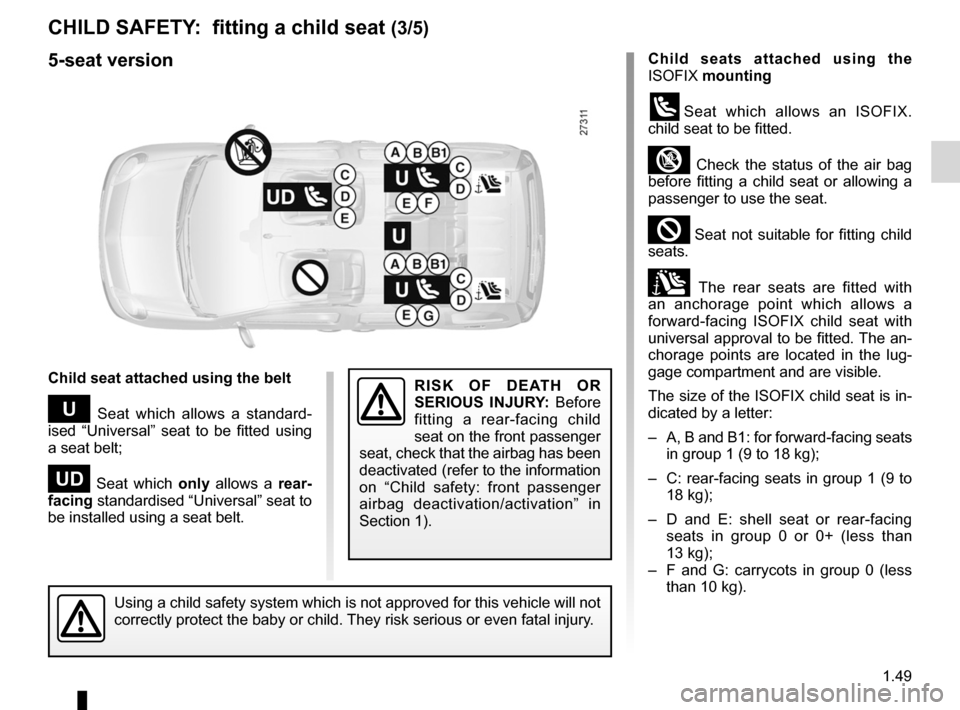
JauneNoirNoir texte
1.49
ENG_UD26558_3
Sécurité enfants : installation du siège enfant (X61 - F61 - R\
enault)
ENG_NU_911-4_F61e_Renault_1
chilD SAFetY : fitting a child seat (3/5)
child seats attached using the
ISOFIX mounting
üSeat which allows an ISOFIX.
child seat to be fitted.
³ Check the status of the air bag
before fitting a child seat or allowing a
passenger to use the seat.
² Seat not suitable for fitting child
seats.
± The rear seats are fitted with
an anchorage point which allows a
forward-facing ISOFIX child seat with
universal approval to be fitted. The an-
chorage points are located in the lug -
gage compartment and are visible.
The size of the ISOFIX child seat is in-
dicated by a letter:
– A, B and B1: for forward-facing seats
in group 1 (9 to 18 kg);
– C: rear-facing seats in group 1 (9 to
18 kg);
– D and E: shell seat or rear-facing
seats in group 0 or 0+ (less than
13 kg);
– F and G: carrycots in group 0 (less
than 10 kg).
child seat attached using the belt
¬ Seat which allows a standard
-
ised “Universal” seat to be fitted using
a seat belt;
− Seat which only allows a rear-
facing standardised “Universal” seat to
be installed using a seat belt.
Using a child safety system which is not approved for this vehicle will not
correctly protect the baby or child. They risk serious or even fatal injury.
r i S K O F D eAt h O r
S eri OUS iNJU rY: Before
fitting a rear-facing child
seat on the front passenger
seat, check that the airbag has been
deactivated (refer to the information
on “Child safety: front passenger
airbag deactivation/activation” in
Section 1).
5-seat version
Page 55 of 213
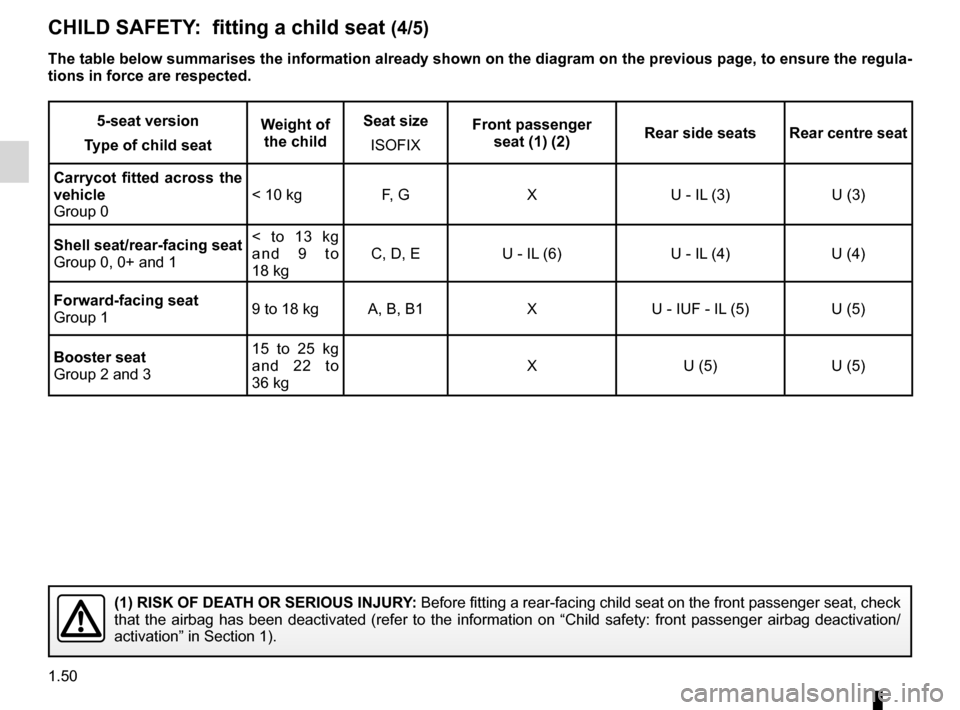
1.50
ENG_UD26558_3
Sécurité enfants : installation du siège enfant (X61 - F61 - R\
enault)
ENG_NU_911-4_F61e_Renault_1
Jaune NoirNoir texte
chilD SAFetY : fitting a child seat (4/5)
5-seat version
t ype of child seat Weight of
the child Seat size
ISOFIX Front passenger
seat (1) (2) rear side seats
rear centre seat
carrycot fitted across the
vehicle
Group 0 < 10 kg
F, G XU - IL (3) U (3)
Shell seat/rear-facing seat
Group 0, 0+ and 1 < to 13 kg
a n d 9 t o
18 kg
C, D, E
U - IL (6) U - IL (4)U (4)
Forward-facing seat
Group 1 9 to 18 kg
A, B, B1 XU - IUF - IL (5) U (5)
Booster seat
Group 2 and 3 15 to 25 kg
a n d 2 2 t o
36 kg
X
U (5)U (5)
(1) riSK OF DeA th Or SeriOUS iNJUrY: Before fitting a rear-facing child seat on the front passenger seat, check
that the airbag has been deactivated (refer to the information on “Child safety: front passenger airbag deactivation/
activation” in Section 1).
the table below summarises the information already shown on the diagram on the previous page, to ensure the regula-
tions in force are respected.
Page 56 of 213
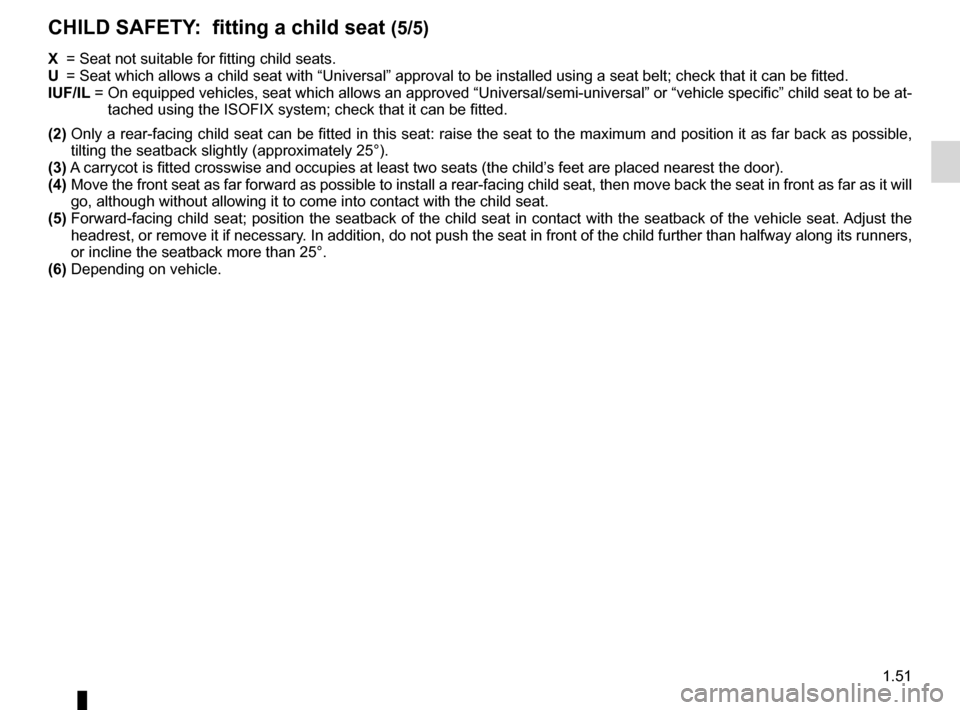
JauneNoirNoir texte
1.51
ENG_UD26558_3
Sécurité enfants : installation du siège enfant (X61 - F61 - R\
enault)
ENG_NU_911-4_F61e_Renault_1
X = Seat not suitable for fitting child seats.
U = Seat which allows a child seat with “Universal” approval to be installed using a seat belt; check that it can be fitted.
iUF/il = On equipped vehicles, seat which allows an approved “Universal/semi-universal” or “vehicle specific” child seat to be at-
tached using the ISOFIX system; check that it can be fitted.
(2) Only a rear-facing child seat can be fitted in this seat: raise the seat to the maximum and position it as far back as possible,
tilting the seatback slightly (approximately 25°).
(3) A carrycot is fitted crosswise and occupies at least two seats (the chil\
d’s feet are placed nearest the door).
(4) Move the front seat as far forward as possible to install a rear-facing child seat, then move back the seat in front as far as it will
go, although without allowing it to come into contact with the child sea\
t.
(5) Forward-facing child seat; position the seatback of the child seat in contact with the seatback of the vehicle seat. Adjust the
headrest, or remove it if necessary. In addition, do not push the seat in front of the child further than halfway along its runners,
or incline the seatback more than 25°.
(6) Depending on vehicle.
chilD SAFetY : fitting a child seat (5/5)
Page 57 of 213
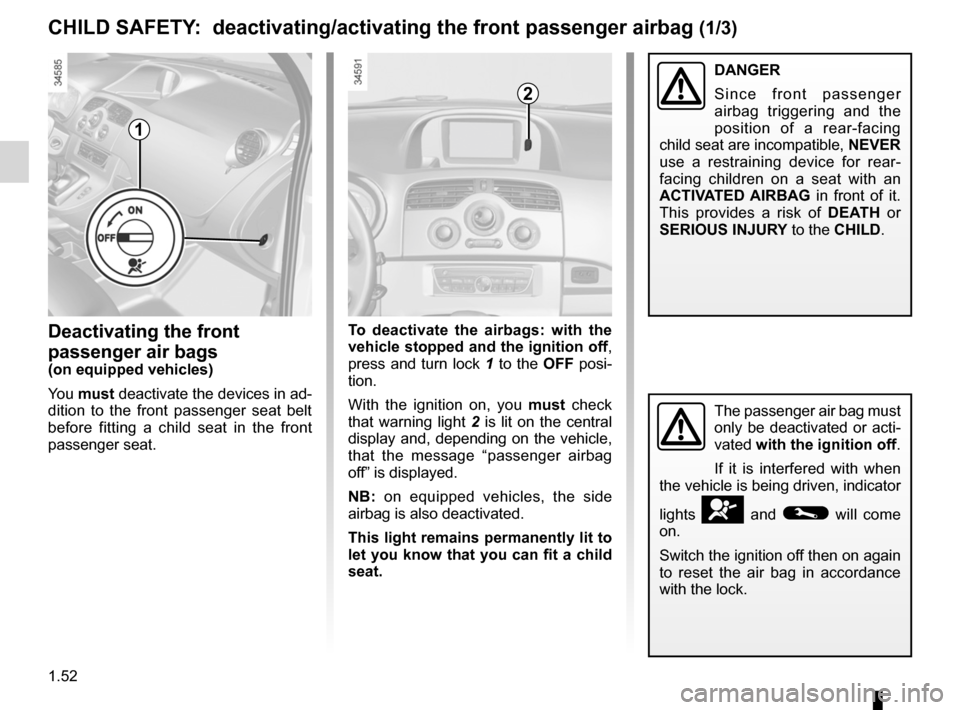
air bagdeactivating the front passenger air bags
(up to the end of the DU)
air bag activating the front passenger air bags
(up to the end of the DU)
child safety ............................................ (up to the end of the DU)
child restraint/seat ................................ (up to the end of the DU)
transporting children ............................. (up to the end of the DU)
front passenger air bag deactivation .... (up to the end of the DU)
child restraint/seat ................................ (up to the end of the DU)
1.52
ENG_UD28660_3
Sécurité enfants : désactivation/activation airbag passager ava\
nt (X61 - F61 - Renault)
ENG_NU_911-4_F61e_Renault_1
Jaune NoirNoir texte
Deactivating/activating the front passenger airbag
Deactivating the front
passenger air bags
(on equipped vehicles)
You must deactivate the devices in ad-
dition to the front passenger seat belt
before fitting a child seat in the front
passenger seat. t
o deactivate the airbags: with the
vehicle stopped and the ignition off,
press and turn lock 1 to the OFF posi-
tion.
With the ignition on, you must check
that warning light 2 is lit on the central
display and, depending on the vehicle,
that the message “passenger airbag
off” is displayed.
NB: on equipped vehicles, the side
airbag is also deactivated.
this light remains permanently lit to
let you know that you can fit a child
seat.
chilD SAFetY : deactivating/activating the front passenger airbag (1/3)
The passenger air bag must
only be deactivated or acti-
vated with the ignition off.
If it is interfered with when
the vehicle is being driven, indicator
lights
å and © will come
on.
Switch the ignition off then on again
to reset the air bag in accordance
with the lock.
2
1
DANger
S i n c e f r o n t p a s s e n g e r
airbag triggering and the
position of a rear-facing
child seat are incompatible, Never
use a restraining device for rear -
facing children on a seat with an
A ctiv Ate D A irBA g in front of it.
This provides a risk of DeAth or
SeriOUS iNJUr Y to the chilD.
Page 58 of 213
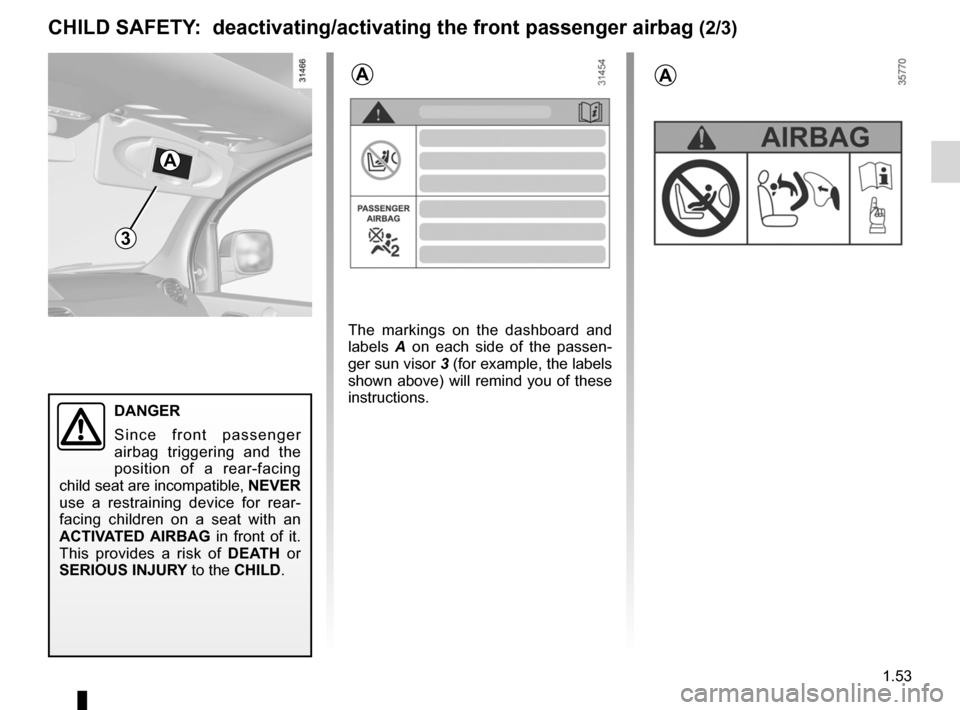
JauneNoirNoir texte
1.53
ENG_UD28660_3
Sécurité enfants : désactivation/activation airbag passager ava\
nt (X61 - F61 - Renault)
ENG_NU_911-4_F61e_Renault_1
chilD SAFetY : deactivating/activating the front passenger airbag (2/3)
3
The markings on the dashboard and
labels A on each side of the passen -
ger sun visor 3 (for example, the labels
shown above) will remind you of these
instructions.
AA
DANger
S i n c e f r o n t p a s s e n g e r
airbag triggering and the
position of a rear-facing
child seat are incompatible, Never
use a restraining device for rear -
facing children on a seat with an
A ctiv Ate D A irBA g in front of it.
This provides a risk of DeAth or
SeriOUS iNJUr Y to the chilD.
A
Page 59 of 213
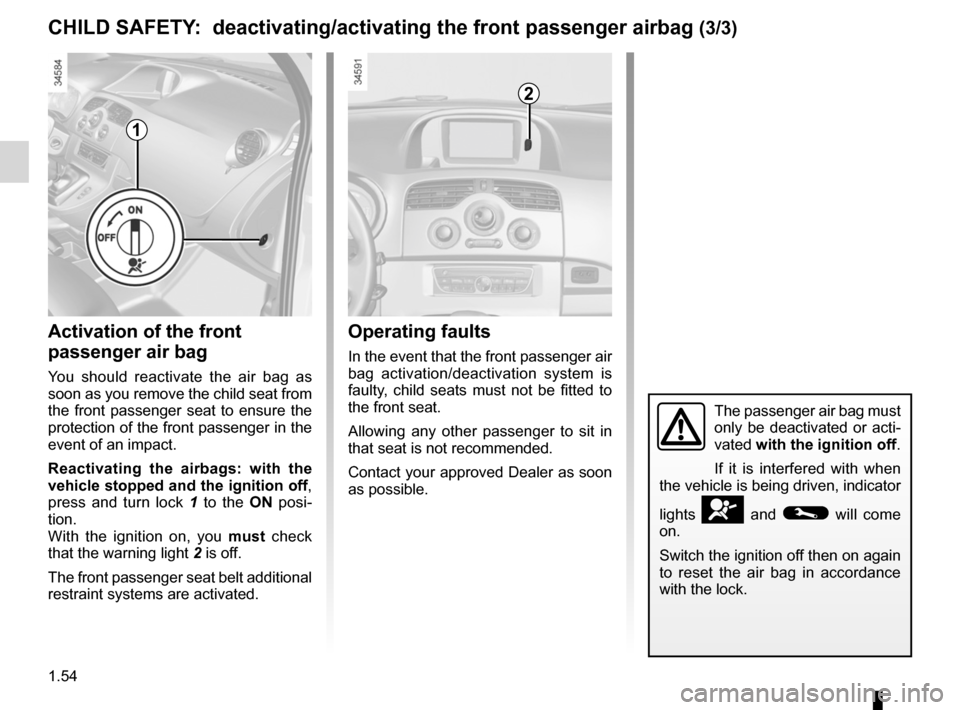
1.54
ENG_UD28660_3
Sécurité enfants : désactivation/activation airbag passager ava\
nt (X61 - F61 - Renault)
ENG_NU_911-4_F61e_Renault_1
The passenger air bag must
only be deactivated or acti-
vated with the ignition off.
If it is interfered with when
the vehicle is being driven, indicator
lights
å and © will come
on.
Switch the ignition off then on again
to reset the air bag in accordance
with the lock.
Operating faults
In the event that the front passenger air
bag activation/deactivation system is
faulty, child seats must not be fitted to
the front seat.
Allowing any other passenger to sit in
that seat is not recommended.
Contact your approved Dealer as soon
as possible.
Activation of the front
passenger air bag
You should reactivate the air bag as
soon as you remove the child seat from
the front passenger seat to ensure the
protection of the front passenger in the
event of an impact.
r eactivating the airbags: with the
vehicle stopped and the ignition off,
press and turn lock 1 to the ON posi -
tion.
With the ignition on, you must check
that the warning light 2 is off.
The front passenger seat belt additional
restraint systems are activated.
2
chilD SAFetY : deactivating/activating the front passenger airbag (3/3)
1
Page 60 of 213
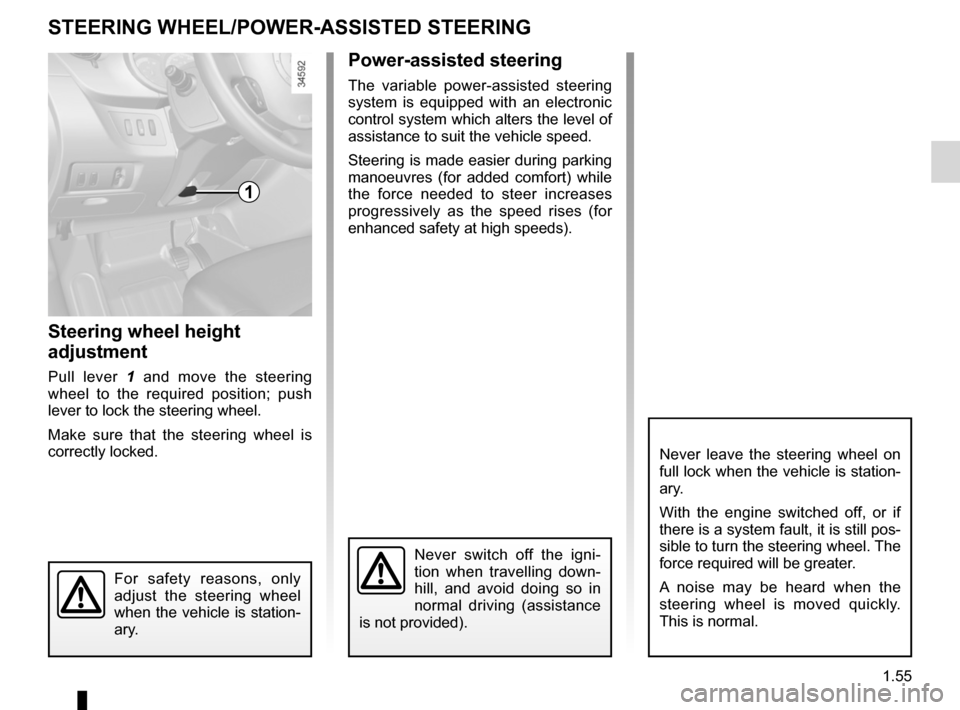
steering wheeladjustment ...................................... (up to the end of the DU)
power-assisted steering ......................................... (current page)
power-assisted steering ......................................... (current page)
1.55
ENG_UD26203_3
Volant de direction (X61 - F61 - Renault)
ENG_NU_911-4_F61e_Renault_1
Steering wheel/Power-assisted steering
SteeriNg Wheel/POWer-ASSiSteD SteeriNg
Steering wheel height
adjustment
Pull lever 1 and move the steering
wheel to the required position; push
lever to lock the steering wheel.
Make sure that the steering wheel is
correctly locked.
For safety reasons, only
adjust the steering wheel
when the vehicle is station-
ary.
1
Never switch off the igni -
tion when travelling down -
hill, and avoid doing so in
normal driving (assistance
is not provided).
Power-assisted steering
The variable power-assisted steering
system is equipped with an electronic
control system which alters the level of
assistance to suit the vehicle speed.
Steering is made easier during parking
manoeuvres (for added comfort) while
the force needed to steer increases
progressively as the speed rises (for
enhanced safety at high speeds).
Never leave the steering wheel on
full lock when the vehicle is station-
ary.
With the engine switched off, or if
there is a system fault, it is still pos-
sible to turn the steering wheel. The
force required will be greater.
A noise may be heard when the
steering wheel is moved quickly.
This is normal.